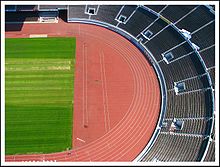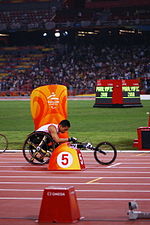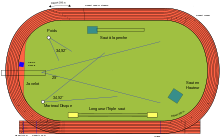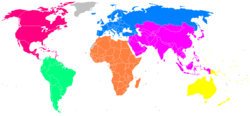
Athletics (sport)
Background Information
This wikipedia selection has been chosen by volunteers helping SOS Children from Wikipedia for this Wikipedia Selection for schools. All children available for child sponsorship from SOS Children are looked after in a family home by the charity. Read more...
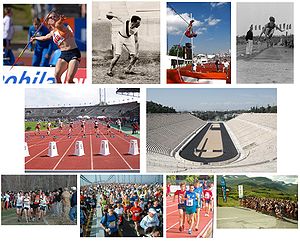 |
|
| Highest governing body | IAAF |
|---|---|
| Characteristics | |
| Mixed gender | Yes |
| Categorization | Outdoor or indoor |
| Olympic | Present since inaugural 1896 Olympics |
| Paralympic | Present since inaugural 1960 Paralympics |
Athletics is one of the World’s most commonly participated sports because of its variety and diversity. Individual's can be talented in one aspect of the sport (whether this be running, jumping, throwing, or walking), specifying to be athletes within their discipline; or all-round athletes can develop skill in many aspects of athletics, allowing them to compete in Decathlons (10 athletic events) or Heptathlons (7 athletic events) - which challenge the entire body. The simplicity of the competitions, and the lack of a need for expensive equipment, makes athletics one of the most commonly competed sports in the world. Athletics is mostly an individual sport, with the exception of relay races and competitions which combine athletes' performances for a team score, such as cross country.
Organized athletics are traced back to the Ancient Olympic Games from 776 BC, and most modern events are conducted by the member clubs of the International Association of Athletics Federations. The athletics meeting forms the backbone of the modern Summer Olympics, and other leading international meetings include the IAAF World Championships and World Indoor Championships, and athletes with a physical disability compete at the Summer Paralympics and the IPC Athletics World Championships.
Etymology
The word athletics is derived from the words ἄθλος ('athlos') meaning "contest" and ἄθλον ('athlon') meaning prize. Initially, the term was used to describe in general – i.e. sporting competition based primarily on human physical feats. In the 19th century in Europe, the term athletics acquired a more narrow definition and came to describe sports involving competitive running, walking, jumping and throwing. This definition continues to be the most prominent one in the United Kingdom and most of the areas of the former . Furthermore, foreign words in many and which are related to the term athletics also have a similar meaning.
In contrast to this, in much of North America athletics is synonymous with sports in general, maintaining a more historic usage of the term. The word "athletics" is rarely used to refer to the sport of athletics in this region. Track and field is preferred, and is used in the United States and Canada to refer to all athletics events, including racewalking and marathon running.
History
Antiquity and Middle Ages
Athletic contests in running, walking, jumping, and throwing are among the oldest of all sports and their roots are prehistoric. Athletics events were depicted in the Ancient Egyptian tombs in Saqqara, with illustrations of running at the Heb Sed festival and high jumping appearing in tombs from as early as of 2250 BC. The Tailteann Games were an ancient Celtic festival in Ireland, founded around 1800 BC, and the thirty-day meeting included running and stone-throwing among its sporting events. The original and only event at the first Olympics in 776 BC was a stadium-length running event known as the stadion. This later expanded to include throwing and jumping events within the ancient pentathlon. Athletics competitions also took place at other Panhellenic Games, which were founded later around 500 BC.
The Cotswold Olimpick Games, a sports festival which emerged in 17th century England, also featured athletics in the form of sledgehammer throwing contests. Annually, from 1796 to 1798, L'Olympiade de la République was held in revolutionary France, and is an early forerunner to the modern summer Olympic Games. The premier event of this competition was a running event, but various ancient Greek disciplines were also on display. The 1796 Olympiade marks the introduction of the metric system into sport.
Modern era
The Royal Military College, Sandhurst has claimed to be the first to adopt this in 1812 and 1825, but without any supporting evidence. The earliest recorded meeting was organised at Shrewsbury, Shropshire in 1840 by the Royal Shrewsbury School Hunt. There are details of the meeting in a series of letters written 60 years later by C.T. Robinson, who was a pupil there from 1838 to 1841. The Royal Military Academy at Woolwich held an organised competition in 1849, but the first regular series of meetings was held by Exeter College, Oxford from 1850.

The first modern-style indoor athletics meetings were recorded shortly after in the 1860s, including a meet at Ashburnham Hall in London which featured four running events and a triple jump competition.
The Amateur Athletic Association (AAA) was established in England in 1880 as the first national body for the sport of athletics and began holding its own annual athletics competition – the AAA Championships. The United States also began holding an annual national competition – the USA Outdoor Track and Field Championships – first held in 1876 by the New York Athletic Club. Athletics became codified and standardised via the English AAA and other general sports organisations in the late 19th century, such as the Amateur Athletic Union (founded in the US in 1888) and the Union des sociétés françaises de sports athlétiques (founded in France in 1889).
An athletics competition was included in the first modern Olympic Games in 1896 and it has been as one of the foremost competitions at the quadrennial multi-sport event ever since. Originally for men only, the 1928 Olympics saw the introduction of women's events in the athletics programme. Athletics is part of the Paralympic Games since the inaugural Games in 1960. Athletics has a very high profile during major championships, especially the Olympics, but otherwise is less popular.
An international governing body, the International Amateur Athletics Federation (IAAF), was founded in 1912; it adopted its current name, the International Association of Athletics Federations, in 2001. The IAAF established separate outdoor World Championships in 1983. In modern times, athletes can receive money for racing, putting an end to the so-called " amateurism" that existed before.
The Comité International Sports des Sourds had been formed by 1922, to govern international deaf sports, including athletics.
The first organized international competitions for athletes with a physical disability (not deaf) began in 1952, when the first international Stoke Mandeville Games were organized for World War II veterans. This only included athletes in a wheelchair. The first Paralympic Games were held in 1960. Competitions would over time be expanded to include mainly athletes with amputations, cerebral palsy and visual impairment, in addition to wheelchair events.
Sports
The International Association of Athletics Federations, the sport's governing body, defines athletics in five disciplines: track and field, road running, race walking, cross country running, and mountain running. All forms of athletics are individual sports with the exception of relay races. However, athletes' performances are often tallied together by country at international championships, and in the case of cross country the finishing times of the top athletes from each team or country are combined to declare a team victor.
Track and field
Track and field competitions emerged in the late 19th century and were typically contested between athletes who were representing rival educational institutions, military organisations and sports clubs. Participating athletes may compete in one or more events, according to their specialities. Men and women compete separately. Track and field comes in both indoor and outdoor formats, with most indoor competitions occurring in winter, while outdoor events are mostly held in summer. The sport is defined by the venue in which the competitions are held – the track and field stadium.
A variety of running events are held on the track which fall into three broad distance categories: sprints, middle-distance, and long-distance track events. Relay races feature teams comprising four runners each, who must pass a baton to their team-mate after a specified distance with the aim of being the first team to finish. Hurdling events and the steeplechase are a variation upon the flat running theme in that athletes must clear obstacles on the track during the race. The field events come in two types – jumping and throwing competitions. In throwing events, athletes are measured by how far they hurl an implement, with the common events being the shot put, discus, javelin, and hammer throw. There are four common jumping events: the long jump and triple jump are contests measuring the horizontal distance an athlete can jump, while the high jump and pole vault are decided on the height achieved. Combined events, which include the decathlon (typically competed by men) and heptathlon (typically competed by women), are competitions where athletes compete in a number of different track and field events, with each performance going toward a final points tally.
The most prestigious track and field contests occur within athletics championships and athletics programmes at multi-sport events. The Olympic athletics competition and World Championships in Athletics, and the Paralympic athletics competition and IPC World Championships in Athletics, are the highest and most prestigious levels of competition in track and field. Track and field events have become the most prominent part of major athletics championships and many famous athletes within the sport of athletics come from this discipline. Discrete track and field competitions are found at national championships-level and also at annual, invitational track and field meets. Meetings range from elite competitions – such as those in the IAAF Diamond League series – to basic all comers track meets, inter-sports club meetings and schools events, which form the grassroots of track and field.
| Track | Field | Combined events | |||||
|---|---|---|---|---|---|---|---|
| Sprints | Middle-distance | Long-distance | Hurdles | Relays | Jumps | Throws | |
| 60 m 100 m 200 m 400 m |
800 m 1500 m 3000 m |
5000 m 10,000 m |
60 m hurdles 100 m hurdles 110 m hurdles 400 m hurdles 3000 m steeplechase |
4×100 m relay 4×400 m relay |
Long jump Triple jump High jump Pole vault |
Shot put Discus throw Hammer throw Javelin throw |
Pentathlon Heptathlon Decathlon |
- Note: Events in italics are competed at indoor world championships only
Road running
Road running competitions are running events (predominantly long distance) which are mainly conducted on courses of paved or tarmac roads, although major events often finish on the track of a main stadium. In addition to being a common recreational sport, the elite level of the sport – particularly marathon races – are one of the most popular aspects of athletics. Road racing events can be of virtually any distance, but the most common and well known are the marathon, half marathon, 10 km and 5 km. The marathon is the only road running event featured at the IAAF World Championships in Athletics and the Summer Olympics, although there is also an annual IAAF World Half Marathon Championships. The marathon is also the only road running event featured at the IPC Athletics World Championships and the Summer Paralympics. The World Marathon Majors series includes the five most prestigious marathon competitions at the elite level – the Berlin, Boston, Chicago, London, and New York City marathons.

The sport of road running finds its roots in the activities of footmen: male servants who ran alongside the carriages of aristocrats around the 18th century, and who also ran errands over distances for their masters. Foot racing competitions evolved from wagers between aristocrats, who pitted their footman against that of another aristocrat in order to determine a winner. The sport became professionalised as footmen were hired specifically on their athletic ability and began to devote their lives to training for the gambling events. The amateur sports movement in the late 19th century marginalised competitions based on the professional, gambling model. The 1896 Summer Olympics saw the birth of the modern marathon and the event led to the growth of road running competitions through annual events such as the Boston Marathon (first held in 1897) and the Lake Biwa Marathon and Fukuoka Marathons, which were established in the 1940s. The 1970s running boom in the United States made road running a common pastime and also increased its popularity at the elite level.
Ekiden contests – which originated in Japan and remain very popular there – are a relay race variation on the marathon, being in contrast to the typically individual sport of road running.
Cross country running
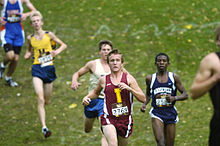
Cross country running is the most naturalistic of the sports in athletics as competitions take place on open-air courses over surfaces such as grass, woodland trails, and earth. It is both an individual and team sport, as runners are judged on an individual basis and a points scoring method is used for teams. Competitions are typically long distance races of 4 km (2.5 mi) or more which are usually held in autumn and winter. Cross country's most successful athletes often compete in long-distance track and road events as well.
The Crick Run in England in 1838 was the first recorded instance of an organised cross country competition. The sport gained popularity in British, then American schools in the 19th century and culminated in the creation of the first International Cross Country Championships in 1903. The annual IAAF World Cross Country Championships was inaugurated in 1973 and this remains the highest level of competition for the sport. A number of continental cross country competitions are held, with championships taking place in Asia, Europe, North America and South America. The sport has retained its status at the scholastic level, particularly in the United Kingdom and United States. At the professional level, the foremost competitions come under the banner of the IAAF Cross Country Permit Meetings.
While cross country competitions are no longer held at the Olympics, having featured in the athletics programme from 1912–1924, it has been present as one of the events within the modern pentathlon competition since the 1912 Summer Olympics. One variation on traditional cross country is mountain running, which incorporates significant uphill and/or downhill sections as an additional challenge to the course. Fell running and Orienteering are other competitive sports similar to cross country, although they feature an element of navigation which is absent from the set courses of cross country.
Racewalking
Racewalking is a form of competitive walking which is usually contested on courses on open-air roads, although running tracks are also occasionally used. Racewalking is the only sport in athletics in which judges monitor athletes on their technique. Racewalkers must always have a foot in contact with the ground and their advancing leg must be straightened, not bent at the knee – failure to follow these rules results in disqualification from the race.
Racewalking finds its roots in the sport of pedestrianism which emerged in the late 18th century in England. Spectators would gamble on the outcome of the walking competitions. The sport took on an endurance aspect and competitions were held over long distances or walkers would have to achieve a certain distance within a specified time frame, such as Centurion contests of walking 100 miles (160 km) within 24 hours. During this period, racewalking was frequently held on athletics tracks for ease of measurement, and the 1908 Summer Olympics in London saw the introduction of the 3500-metre and 10-mile walks. Racewalking was briefly dropped from the Olympic programme in 1928, but the men's 50 kilometres race walk has been held at every Olympic Games but one since 1932. The men's 20 kilometres race walk was added to the Olympic athletics schedule in 1956 and the women's event was first held in 1992. The most common events in modern competition are over 10 km, 20 km and 50 km on roads, although women's 3 km and men's 5 km are held on indoor tracks.
The highest level racewalking competitions occur at the IAAF World Championships in Athletics and at the Summer Olympics, although the sport also has its own separate major competition – the IAAF World Race Walking Cup – which has been held since 1961. The IAAF World Race Walking Challenge forms the primary seasonal competition – athletes earn points for their performances at ten selected racewalking competitions and the highest scoring walkers are entered into that year's IAAF Race Walking Challenge Final.
Categories
- Under 23, under the age of 23 years (only for EAA)
- Junior, under the age of 20 years (for IAAF)
- Youth, under the age of 18 years (for IAAF)
Athletes with a disability
Athletes with a physical disability have competed at separate international events since 1952. It is governed by IPC Athletics, and is one of the sports at the Summer Paralympic Games since 1960.
Competiors at elite level competitions, are classified by disability, to arrange athletes with a similar disability in the same event. A classified T12 athlete for example, is a track athlete with a visual impairment.
- F = Field athletes
- T = Track athletes
- 11–13 – Visual impairment. Compete with a sighted guide.
- 20 – Intellectual disability
- 31–38 – Cerebral palsy
- 41–46 – Amputation, and others (including athletes with dwarfism)
- 51–58 – Wheelchair
In wheelchair racing athletes compete in lightweight racing chairs. Most major marathons have wheelchair divisions and the elite racers consistently beat the runners on foot.
Occasionally, athletes with a disability excel to compete with able bodied athletes. Legally blind Marla Runyan ran in the 2000 and 2004 Olympics and won a gold medal in the 1500 metres at the 1999 Pan American Games. Oscar Pistorius, a double amputee, has competed in the 2012 Olympics. At the 2011 World Championships Pistorius successfully made it to the 400 metres semi-final round and won a silver medal as part of South Africa's 4x400 metres relay team. In Masters athletics it is far more common to make an accommodation for athletes with a disability. Blind Ivy Granstrom set numerous Masters world records while being guided around the track.
Venues
Professional athletics almost exclusively takes place in one of three types of venue: stadiums, set courses on grass or woodland, and road-based courses. Such venues ensure that events take place in a relatively standardised manner, as well as improving the safety of athletes and enjoyment for spectators. At a more basic level, many forms of athletics demand very little in terms of venue requirements; almost any open space or area of field can provide a suitable venue for basic running, jumping and throwing competitions.
Track and field stadia
A standard outdoor track is in the shape of a stadium, 400 metres in length, and has at least eight lanes 1.22 m in width. Older track facilities may have nonstandard track lengths, such as 440 yards (402.3 m) (common in the United States). Historically, tracks were covered by a dirt running surface. Modern All-weather running tracks are covered by a synthetic weather-resistant running surface, which typically consists of rubber (either black SBR or colored EPDM granules), bound by polyurethane or latex resins. Older tracks may be cinder-covered.
A standard indoor track is designed similarly to an outdoor track, but is only 200 metres in length and has between four and eight lanes, each with width between 0.90 m and 1.10 m. Often, the bends of an indoor track will be banked to compensate for the small turning radius. However, because of space limitations, indoor tracks may have other nonstandard lengths, such as 160-yard (146.3 m) indoor track at Madison Square Garden used for the Millrose Games. Because of space limitations, meetings held at indoor facilities do not hold many of athletics events typically contested outdoors.
Cross country courses
There is no standardised form of cross country course and each venue is significantly defined by the environment it contains – some may be relatively flat and featureless, while others may be more challenging with natural obstacles, tight turns, and undulating ground. While a small number of purpose-built courses exist, the vast majority of cross country running courses are created by cordoning a specific area within any open natural land, typically a park, woodland or greenspace near a settlement.
At the elite and professional level, courses must be looped and each lap must be between 1750 m and 2000 m in length. Severe obstacles such as deep ditches, high barriers and thick undergrowth not normally present; the course should be able to be completed whilst remaining on foot throughout. In order to maintain the sport's distinction from road running, the usage of unnatural or macadamised surfaces is generally kept to a minimum or avoided entirely.
Due to the fact that the majority of races take place on areas of grass, soil, mud or earth, weather conditions can significantly affect the difficulty of cross country courses, as snow and rain reduces traction and can create areas of standing water.
Road courses
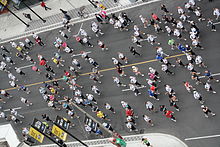
The surface of road races is highly important and the IAAF dictate that the courses must be along man-made roads, bicycle paths or footpaths. Courses set along major roads of cities are typical of road running events, and traffic is usually cordoned off from the area during the competition. While soft ground, such as grass, is generally avoided, races may start and finish on soft ground or within a track and field stadium. Road racing courses come in two primary types: looped and point-to-point. Courses may be measured and designed to cover a standardised distance, such as 10 km (6.2 mi), or they may simply follow a set route between two landmarks.
Road running courses over 5 km usually offer drinks or refreshment stations for runners at designated points alongside the course and medical professionals are present at the courses of major races due to the health risks involved with long-distance running.
Elite road walks are conducted on closed loop courses (usually loops of 2,000 or 2,500 meters). Refreshment stations are also present over long distance walking competitions, with drinks being available on every lap for races longer than 10 km.
Organizations
Since its foundation in 1912, the international governing body for athletics has been the International Association of Athletics Federations (IAAF). It was initially known as the International Amateur Athletics Federation but changed later its name to reflect that the sport had moved away from amateurism towards professionalism in the late 1970s. The IAAF has 213 member nations and territories, which are divided into six continental areas (or area associations). The six association areas are for Asia, Africa, Europe, Oceania, North America and South America. The sports within athletics do not have their own independent governing bodies at either international or continental level and, instead, all fall under the athletics authorities.
- AAA – Asian Athletics Association
- CAA – Confederation of African Athletics
- CONSUDATLE – South American Athletics Confederation
- NACACAA – North America, Central America and Caribbean Athletic Association
- EAA – European Athletics Association
- OAA – Oceania Athletics Association
National level athletics organisations are responsible for the regulation of the sport within their respective countries and most major competitions have some form of permit or approval from their national body.
Competitions
Athletics competitions can be broadly divided into three types: international championships, national championships, and annual meetings and races. Athletics at international championships, or Games, represent the pinnacle of competition within the sport, and they are contested between athletes representing their country or region. The organisation of these competitions is usually overseen by either a world, continental, or regional athletics governing body. Athletes gain entry into these competitions by earning selection from their national athletics governing body, which is generally done by assessing athletes via their past achievements or performances at a national selection event. National championships are annual competitions endorsed by a national governing body which serve the purpose of deciding the country's best athlete in each event. Annual one-day meetings and races form the most basic level of competition and are the most common format of athletics contests. These events are often invitational and are organised by sports organisations, sports promoters, or other institutions.
Competitions typically feature only one of the sports within athletics. However, major outdoor international athletics championships and athletics competitions held as part of multi-sport events usually feature a combination of track and field, road running and racewalking events
International championships
Olympic Games

The modern Summer Olympics was the first event at which a global athletics competition took place. All the four major sports within athletics have featured in the Olympic athletics programme since its inception in 1896, although cross country has since been dropped. The Olympic competition is the most prestigious athletics contest and, in addition to this, many athletics events are also among the most prominent competitions at the Summer Olympics as a whole. A total of 47 athletics events are held at the Olympics, 24 for men and 23 for women. The events within the men's and women's programmes are either identical or have a similar equivalent, with the sole exception being that men contest the 50 km race walk.
Paralympic Games
The Summer Paralympics include athletes with a physical disability. Track and field, and road events have featured in the Paralympic athletics programme since its inception in 1960. The Paralympic competition is the most prestigious athletics contest where athletes with a physical disability compete.
Athletics at the Paralympic Games also include wheelchair racing where athletes compete in lightweight racing chairs. Athletes with a visual impairment compete with a sighted guide. At the 2012 Summer Paralympics in London, for the first time at an international athletics event, the guides will receive medals, such as the pilots in cycling, and the guides at the Paralympic Winter Games have done for a while.
World Championships
The IAAF World Championships in Athletics is the primary global athletics championships held by IAAF. The biennial competition was first held in 1983 and now features an event programme which is identical to the Olympics. Thus, road running, racewalking and track and field are the sports which feature at the competition. Cross country running has its own discrete global championships – the IAAF World Cross Country Championships – which has been held annually since 1973. The IAAF World Indoor Championships in Athletics is a biennial athletics championships which features solely indoor track and field events. The foremost separate road running event is the annual IAAF World Half Marathon Championships (formerly World Road Running Championships). While not having official world championship status, the biennial IAAF World Race Walking Cup fulfils a similar role for the sport of racewalking. Outdoor track and field is the only sport in athletics that does not have a its own distinct global championship which is separate from other types of athletics, although the IAAF Continental Cup (a quadrennial competition between continental teams) is composed entirely of outdoor track and field events.
Other world championships include the IAAF World Junior and World Youth Championships in Athletics, which are for athletes under-19 and under-17, respectively. World Masters Athletics conducts the World Masters Athletics Championships for athletes in 5 year age divisions over the age of 35. The now defunct IAAF World Road Relay Championships served as the global event for ekiden marathon relay races.
Elite athletes with a physical disability compete at the IPC Athletics World Championships and at the Commonwealth Games.
Commonwealth Games
Athletics is one of the sports at the quadrennial Commonwealth Games competition. It has been a Commonwealth Games sport since the inaugural edition of the event's precursor, the 1930 British Empire Games. It is a core sport and must be included in the sporting programme of each edition of the Games.
Universiade
Athletics is one of the sports at the biennial summer Universiade competition. It has been one of the event's competed sports since the inaugural edition.

